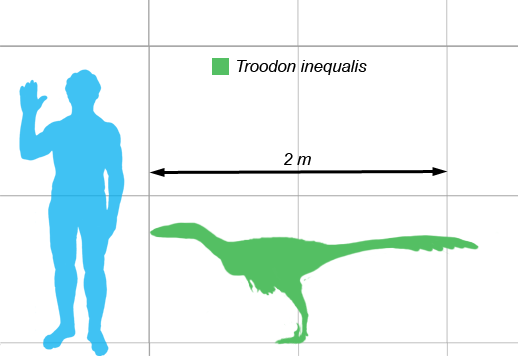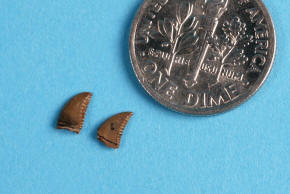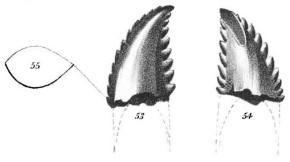|
Description
Troodon
was a small dinosaur, around 2.4 metres (7.9 ft) in length, and weighing on
the order of 50 kilograms (110 lb). Troodon
is the largest known troodontid. It had very long, slender hind limbs,
suggesting that the animal was able to run quickly. It had large,
retractable sickle-shaped claws on its second toes, which were raised off
the ground when running.
Its eyes were large (perhaps
suggesting a partially nocturnal lifestyle),
and slightly forward facing, giving
Troodon
some degree of depth perception. Their
light skulls contained a capsule similar to those found in ostrich
dinosaurs.
Brain
Troodon
had one of the largest known brains of any dinosaur, relative to its body
mass (comparable to modern birds). Troodon's
cerebrum-to-brain-volume ratio was 31.5% to 63% of the way from a nonavian
reptile proportion to a truly avian one.
History and classification
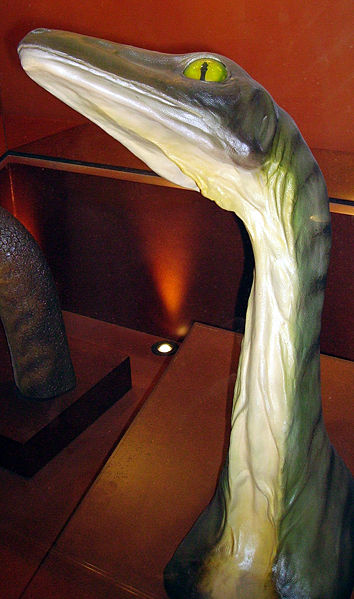 |
| Head and neck of Dale Russell's Stenonychosaurus sculpture,
Natural History Museum, London (Picture
Source) |
Troodon
was originally spelled Tro÷don
(with a
diaeresis) by
Joseph Leidy in 1856, which was officially
amended to its current status by Sauvage in 1876. The
type specimen of
Troodon has caused
problems with classification, as the entire genus is based only on a single
tooth from the
Judith River Formation.
The first specimen currently
assigned to Troodon
that was not a tooth was named Stenonychosaurus
by Sternberg in 1932, based on a foot, fragments of a hand, and some tail
vertebrae from
Alberta. A remarkable
feature of these remains was the enlarged claw on the second toe, which is
now recognized as characteristic of
Deinonychosauria.
A more complete skeleton of
Stenonychosaurus was
described by
Dale Russell in 1969
from the
Dinosaur Park Formation,
which eventually formed the scientific foundation for a famous life-sized
sculpture of Stenonychosaurus.
Stenonychosaurus
became a well-known theropod in the 1980s, when the feet and braincase were
described in more detail. Along with
Saurornithoides, it
formed the family Saurornithoididae. Based on differences in tooth
structure, and the extremely fragmentary nature of the original
Troodon specimens,
Saurornithoidids were thought to be close relatives while
Troodon was considered a
dubious possible relative of the family.
Phil Currie, reviewing
the pertinant specimens in 1987, showed that supposed differences in tooth
and jaw structure among troodontids and saurornithoidids were based on age
and position of the tooth in the jaw, rather than a difference in species.
All of the specimens once called
Stenonychosaurus are now referred to as
Troodon in the recent
scientific literature.
Distribution
Troodon
is known from the
Judith River Formation
and the upper
Two Medicine Formation
of Montana, the
Judith River Group of
Alberta, the
Horseshoe Canyon Formation
of Alberta, the
Prince Creek Formation
of Alaska, and in the
famous
Lance and
Hell Creek Formations
of the USA. There is some evidence that Troodon
favored cooler climates, as it seems to have been particularly abundant in
northern and even arctic areas and during
cooler intervals, such as the early
Maastrichtian. Possible
Troodon teeth have been
found in the lower
Javelina Formation of
Texas and the Naashoibito Member of the
Kirtland Formation in
New Mexico.
It seems unlikely that all of these
fossils, which come from localities hundreds or thousands of miles apart,
separated by millions of years of time, represent a single species of
Troodon. However, further
study and more fossils are needed to determine how many species of
Troodon existed.
Paleobiology
Troodon
is thought to have been a predator like other
theropods. This view is supported by its Maniraptoran features (sickle claw
on foot) and apparently good
binocular vision.
Troodon
teeth, however, are different from most other theropods. One
comparative study of the feeding apparatus suggests that
Troodon could have been an
omnivore. The jaws met in a broad, U-shaped
symphysis similar to
that of an
iguana, a lizard
species adapted to a plant-eating lifestyle. Additionally, the teeth of
Troodon bore large
serrations each of which is called a
denticle. There are pits at the
intersections of the denticles, and the points of the denticles point
towards the tip, or apex, of each tooth. The teeth show wear facets on their
sides. Holtz (1998) also noted that characteristics used to support a
predatory habit for Troodon
- the grasping hands, large brain and stereoscopic vision, are all
characteristics shared with the herbivorous/omnivorous
primates and omnivorous
Procyon (raccoon).
One study was based on the many
Troodon teeth that
have been collected from Late Cretaceous deposits from northern Alaska.
These teeth are much larger than those collected from more southern sites,
providing evidence that northern Alaskan populations of
Troodon grew to larger
average body size. The study suggests that the Alaskan
Troodons may have had
access to large animals as prey because there were no tyrannosaurids in
their habitat to provide competition for those resources. This study also
provides an analysis of the proportions and wear patterns of a large sample
of Troodon teeth.
It proposes that the wear patterns of all
Troodon teeth suggest a diet of soft foods -
inconsistent with bone chewing, invertebrate exoskeletons, or tough plant
items. This study hypothesizes a diet primarily consisting of meat
Age determination
studies performed on the fossilized remains of
Troodon using growth ring counts suggest that
this dinosaur reached its adult size probably in 3ľ5 years.
Reproduction
Dinosaur eggs and nests were
discovered by
John R. Horner in 1983
in the Two Medicine
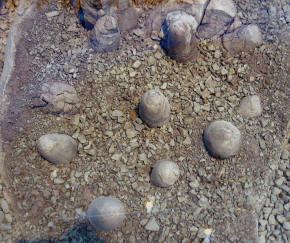 |
| A clutch of Troodon formosus eggs partly encased in
matrix. Museum of the Rockies specimen on loan to the Burke Museum.
(Picture
Source) |
Formation of Montana. Varriccho et al. (2002) have
described eight of these nests found to date. These are all in the
collection of the
Museum of the Rockies.
Horner (1984) found isolated bones and partial skeletons of the
hypsilophodont Orodromeus
very near the nests in the same horizon and described the eggs as those of
Orodromeus. Horner and
Weishampel (1996) reexamined the embryos preserved in the eggs and
determined that they were those of Troodon,
not Orodromeus.
Varricchio et al. (1997) made this determination with even more certainty
when they described a partial skeleton of an adult
Troodon in
contact with a clutch of at least five eggs, probably in a
brooding position.
Varricchio et al. (1997) described
the exact structure of Troodon
nests. They were built from sediments, they were dish shaped, about 100 cm
in internal diameter, and with a pronounced raised rim encircling the eggs.
The more complete nests had between 16 and 24 eggs. The eggs are shaped like elongated teardrops, with the more
tapered ends pointed downwards and imbedded about halfway in the sediment.
The eggs are pitched at an angle so that, on average, the upper half is
closer to the center of the nest. There is no evidence that plant matter was
present in the nest.
Varricchio et al.(1997) were able to
extract enough evidence from the nests to infer several characteristics of
Troodon
reproductive biology. The results are that
Troodon appears to have a type of reproduction
that is intermediate between crocodiles and birds, as phylogeny would
predict. The eggs are statistically grouped in pairs, which suggests that
the animal had two functional oviducts, like crocodiles, rather than one, as
in birds. Crocodiles lay many eggs that are small proportional to adult body
size. Birds lay fewer, larger, eggs. Troodon
was intermediate, laying an egg of about 0.5 kg for a 50 kg adult. This is
10 times larger than reptiles of the same mass, but two
Troodon eggs are roughly
equivalent to the 1.1 kg egg predicted for a 50 kg bird.
Varricchio et al. also found
evidence for iterative laying, where the adult might lay a pair of eggs
every one or two days, and then ensured simultaneous hatching by delaying
brooding until all eggs were laid. MOR 363 was found with 22 empty (hatched)
eggs, and the embryos found in the eggs of MOR 246 were in very similar
states of development, implying that all of the young hatched
simultaneously. The embryos had an advanced degree of skeletal development,
implying that they were
precocial or even
superprecocial. The authors estimated 45 to
65 total days of adult nest attendance for laying, brooding, and hatching.
The authors found no evidence that the young remained in the nest after
hatching and suggested that they dispersed like hatchling crocodiles or
megapode birds instead.
Varricchio et al. (2008) examined
the bone histology of Troodon
specimen MOR 748 and found that it lacked the bone resorption patterns that
would indicate it was an egg-laying female. They also measured the ratio of
the total volume of eggs in Troodon
clutches to the body mass of the adult. They graphed correlations between
this ratio and the type of parenting strategies used by extant birds and
crocodiles and found that the ratio in Troodon
was consistent with that in birds where only the adult male broods the eggs.
From this they concluded that Troodon
females likely did not brood eggs, that the males did, and this may be a
character shared between maniraptoran dinosaurs and basal birds.
If you ordered the Test Pack, it is now time to
take Test 5.
Return to the
Old Earth Ministries Online Dinosaur
Curriculum homepage.

Shopping
Bay
State Replicas - None
Black
Hills Institute - None
|

